University of Chicago Law School
The University of Chicago Law School (Chicago Law) is a professional graduate school of the University of Chicago. It is consistently ranked among the top five law schools in the world, and has produced many distinguished alumni in the judiciary, academia, government, politics and business. It employs more than 200 full-time and part-time faculty and hosts more than 600 students in its Juris Doctor program, while also offering the Master of Laws, Master of Studies in Law and Doctor of Juridical Science degrees in law.
| The University of Chicago Law School | |
|---|---|
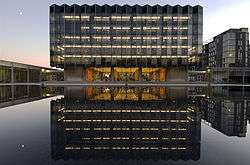 | |
| Parent school | University of Chicago |
| Established | 1902 |
| School type | Private |
| Dean | Thomas J. Miles |
| Location | Chicago, Illinois, U.S. |
| Enrollment | 597[1] |
| Faculty | 203[1] |
| USNWR ranking | 4th[2] |
| Bar pass rate | 98.58%[1] |
| Website | www |
| ABA profile | Standard 509 Report (2017) |
 | |
The law school was conceived in 1902 by the President of the University of Chicago, William Rainey Harper. Harper and the law school's first Dean, Joseph Henry Beale, designed the school's curriculum with inspiration from Ernst Freund's interdisciplinary approach to legal education.[3] The construction of the school was financed by John D. Rockefeller and the cornerstone was laid by President Theodore Roosevelt. The law school opened for classes in 1903.
In the 1930s, the law school's curriculum was transformed by the emergence of the law and economics movement. Economists Aaron Director and Henry Calvert Simons taught courses integrated with the antitrust curriculum taught by statesman Edward H. Levi, leading to the development of the Chicago school of economics and the Chicago School approach to antitrust law.[4] The law school expanded rapidly in the 1950s under Levi's leadership and, in the 1970s and 1980s, many scholars with connections to the social sciences were attracted to the school's influence in law and economics, including Nobel laureates Ronald Coase and Gary Becker and the most cited legal scholar of the 20th century, Richard A. Posner.[5] Cass Sunstein and Richard Epstein, two of the three most-cited legal scholars of the early 21st century, were both members of the Chicago faculty for many years, as well.
The law school's flagship publication is the University of Chicago Law Review. Students edit two other independent law journals, with another three journals overseen by faculty. The law school was originally housed in Stuart Hall, a Gothic-style limestone building on the campus's main quadrangles. Since 1959, it has been housed in an Eero Saarinen-designed building across the Midway Plaisance from the main campus of the University of Chicago. The building was expanded in 1987 and again in 1998. It was renovated in 2008, preserving most of Saarinen's original structure.
History
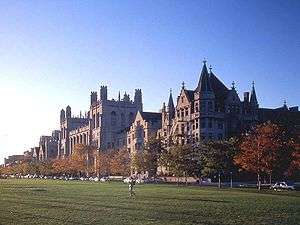
In 1902, the President of the University of Chicago, William Rainey Harper, requested assistance from the faculty of Harvard Law School in establishing a law school at Chicago. Joseph Henry Beale, then a professor at Harvard, was granted a two-year leave of absence to serve as the first Dean of the law school. Beale and Harper assembled the faculty and designed the curriculum, which was inspired by jurist and professor Ernst Freund. Freund had suggested that the school advocate an interdisciplinary approach to legal studies, offering elective courses in subjects such as history and political science.[6]
In 1903, the law school opened for classes in the University Press Building (currently the Bookstore Building). John D. Rockefeller paid the $250,000 construction cost, and President Theodore Roosevelt laid its cornerstone.[7] At the time of its opening, the law school consisted of five faculty members and 78 students. In 1904, the law school moved to Stuart Hall on the main University campus. In the same year, Sophonisba Breckinridge became the first woman to graduate from the law school. The law school also established its first alumni association.[8]
There was considerable change in the law school in the years leading up to World War I and shortly thereafter. The law school established a chapter of the Order of the Coif in 1911. It established the Moot Court program in 1914. During World War I, enrollment at the law school declined: in Spring 1917, 241 students were enrolled; this number dropped to 46 by Fall 1918. In 1920, Earl B. Dickerson became the first African-American to graduate from the law school.[9] In 1926, enrollment reached 500 students for the first time and, in 1927, the law school began to offer its first seminars.
.jpg)
In the 1930s, the law school's curriculum transformed to reflect the emerging influence of the law and economics movement. Aaron Director and Henry Simons began offering economics courses in 1933.[10] Faculty member Edward Levi also introduced economics in the antitrust course, permitting Director to teach one of every five classroom sessions.[11] The first volume of the University of Chicago Law Review was also published in 1933.[12] The law school established a legal writing program in 1938 and the Law and Economics Program in 1939. The LL.M. program was established in 1942, while Harry A. Bigelow Teaching Fellowships were established in 1947. As was the case during World War I, enrolment at the law school, like at many of the other top law schools in the country, declined and its academic calendar was adjusted to meet military needs.[13]
In the 1950s and 1960s, the law school experienced a period of profound growth and expansion under the leadership of Edward Levi, who was appointed Dean in 1950. In 1951, Karl Llewellyn and Soia Mentschikoff joined the law school, the latter being the first woman on the faculty. In 1958, Director founded the Journal of Law and Economics. In 1959, the law school moved to its current building on 60th Street, designed by Eero Saarinen. In 1960, constitutional law scholar Philip Kurland founded the Supreme Court Review. Levi later served as the Provost (1962–1968) and the President (1968–1975) of the University of Chicago, before becoming the United States Attorney General under President Gerald Ford. During his time at the law school, Levi also supported the Committee on Social Thought graduate program.[14]
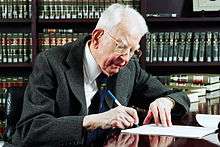
By the 1970s and 1980s, the law and economics movement had attracted a series of scholars with strong connections to the social sciences, such as Nobel laureates Ronald Coase and Gary Becker and scholars Richard A. Posner and William M. Landes. In 1972, Posner founded the Journal of Legal Studies. The law school also established joint degree programs with the Committee on Public Policy Studies and the Department of Economics, complementing Max Rheinstein's Foreign Law Program, which was established in the 1950s with a bequest from the Ford Foundation. The Legal History Program was established in 1981.[15] In 1982, the Federalist Society was established by a group of students at the law school, together with students from Harvard Law School and Yale Law School.
Academics
The law school currently employs more than 200 full-time and part-time faculty members and enrolls approximately 600 students in its Juris Doctor (J.D.) program.[16] It also offers advanced legal degrees such as the Master of Laws (LL.M.), the Master of Legal Studies (M.L.S.) and the Doctor of Jurisprudence (J.S.D.).
Clinics
The school offers seven legal clinics, in which students earn course credit while practicing law under the direction of the clinic's independent faculty.
- Edwin F. Mandel Legal Aid Clinic, which includes clinics on civil justice, criminal law, employment law, housing initiatives and mental health advocacy
- Exoneration Project Clinic
- Innovation Clinic
- Institute for Justice Clinic on Entrepreneurship
- Jenner & Block Supreme Court and Appellate Clinic
- Kirkland & Ellis Corporate Lab Clinic
- Young Center Immigrant Child Advocacy Clinic
Policy initiatives
|
Research centers
|
Programs
|
D'Angelo Law Library
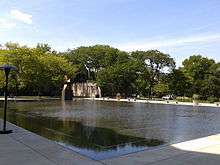
The D'Angelo Law Library is part of the greater University of Chicago library system. Renovated in 2006, it features a second-story reading room. The Law Library is open 90 hours per week and employs 11 full-time librarians and 11 additional managers and staff members. It has study space for approximately 500 people, a wireless network and 26 networked computers. It contains over 700,000 volumes of books, with approximately 6,000 added each year, including materials in over 25 languages, and primary law from foreign countries and international organizations.[17]
Admissions and cost
Admission to the J.D. program is highly competitive: in 2017, the law school enrolled 179 students from an applicant pool of 4,459.[18] For the entering class of 2017, the 25th and 75th LSAT percentiles were 166 and 172, respectively, with a median of 170.[18] The 25th and 75th GPA percentiles were 3.73 and 3.95, respectively, with a median of 3.90.[19] This median placed the law school second in the United States, behind only Yale Law School, for the highest median GPA for admission.
Admission into the LL.M. program is also competitive: in 2018, the law school reported that it had received approximately 1,000 applications for 75 positions.[20]
The total cost of attendance (indicating the cost of tuition, fees and living expenses) at the law school for the 2017–18 academic year was $93,414.[19]
Grading
The law school employs a grading system that places students on a scale of 155–186. The scale was 55–86 prior to 2003, but since then the law school has used a prefix of "1" to eliminate confusion with the traditional 100 point grading scale. For classes of more than 10 students, professors are required to set the median grade at 177, with the number of grades above 180 approximately equaling the number of grades below a 173.[21]
In an article published in The New York Times in 2010, business writer Catherine Rampell criticized other schools' problems with grade inflation, but commended Chicago's system, saying "[Chicago] has managed to maintain the integrity of its grades."[22]
A student graduates "with honors" if he or she attains a final average of 179, "with high honors" upon attaining a final average of 180.5, and "with highest honors" upon attaining a final average of 182. The last of these achievements is rare; typically only one student every few years will attain the requisite 182 average. Additionally, the law school awards two honors at graduation that are based on class rank. Of the students who earned at the law school at least 79 of the 105 credits required to graduate, the top 10% are elected to the "Order of the Coif."[23] Students finishing their first or second years in the top 5% of their class, or graduating in the top 10%, are honored as "Kirkland and Ellis Scholars."[23]
Employment
In 2018, the law school was ranked first in the United States by the National Law Journal for overall employment outcomes.[24] According to the law school's official 2017 ABA-required disclosures, more than 98% of the Class of 2017 obtained full-time, long-term, JD-required employment within ten months of graduation.[19] The law school has the third-highest gross and third-highest per capita placement of alumni in Supreme Court of the United States clerkships.[25] Between 1992 and 2017, it placed 88 alumni in Supreme Court of the United States clerkships. In the Class of 2017, 21.4% of its graduates secured federal clerkships, while 63% of its graduates secured positions at law firms with more than 500 lawyers.[19]
The median salary for its graduates in the Classes of 2016 and 2017 was $180,000, and 75% of graduates earned starting salaries of $180,000 or greater upon graduation.[19] In 2018, the law school was ranked first in the United States by the National Law Journal for placing the highest percentage of recent graduates in federal clerkships and law firms of 100 or more lawyers.[26] It also had the highest first-time Bar pass rate (98.6%) of all law schools in the United States.[19]
Rankings
The law school is ranked first of all law schools in the United States by Above the Law,[27] second by Business Insider,[28] third in the United States in terms of scholarly impact[29] and fourth by U.S. News & World Report.[2] It is ranked fourth in the world by the Academic Ranking of World Universities[30] and by the Times Higher Education World University Rankings.[31]
Publications and organizations
Journals
The law school produces six professional journals. Three of those journals are student-run: the University of Chicago Law Review, the Chicago Journal of International Law, and the University of Chicago Legal Forum. The other three are overseen by faculty: the Supreme Court Review, the Journal of Law and Economics and the Journal of Legal Studies.
Academic paper series
The law school produces several series of academic papers, including the Kreisman Working Papers Series in Housing Law and Policy, the Coase-Sandor Working Paper Series in Law and Economics, the Fulton Lectures, and the Public Law and Legal Theory Working Papers, in addition to a series of occasional papers.[32]
Organizations
There are approximately 60 student-run organizations at the law school which fall under the umbrella of the Law Students Association. It is home to one of the three founding chapters of the Federalist Society. As a professor, former Supreme Court justice Antonin Scalia helped to organize the Chicago chapter of the society.[33] Chicago is also home to a large chapter of the progressive American Constitution Society for Law and Policy.
Architecture
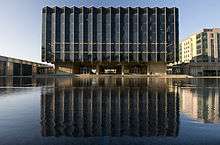
The law school was originally housed in Stuart Hall, a Gothic-style limestone building on the campus's main quadrangles. Needing more library and student space, the law school moved across the Midway Plaisance to its current, Eero Saarinen-designed building (next to what was then the headquarters of the American Bar Association) in October 1959. The building contains classrooms, the D'Angelo Law Library, faculty offices, and an auditorium and courtroom, arranged in a quadrangle around a fountain (mimicking the college Gothic architecture of the campus's main quadrangles). The year saw a number of celebrations of the law school's new home, including a filming of The Today Show and appearances by Chief Justice Earl Warren, Governor (and later Vice President) Nelson Rockefeller and Secretary-General of the United Nations Dag Hammarskjöld.[34]
In 1987, and over the objections of the Saarinen family, the building was expanded to add office and library space (and the library renamed in honor of alumnus Dino D'Angelo). In 1998, a dedicated space for the law school's clinics, the Arthur Kane Center for Clinical Legal Education, as well as numerous additional classrooms, were constructed.[34] Renovation of the library, classrooms, offices, and fountain was completed in 2008, notable for the preservation of most of Saarinen's structure at a time when many modernist buildings faced demolition.[35][36]
Deans
- Joseph Henry Beale (1902–1904)
- James Parker Hall (1904–1928)
- Harry A. Bigelow (1929–1939)
- Wilber G. Katz (1939–1950)
- Edward H. Levi (1950–1962)
- Phil Neal (1963–1975)
- Norval Morris (1975–1979)
- Gerhard Casper (1979–1987)
- Geoffrey R. Stone (1987–1993)
- Douglas Baird (1994–1999)
- Daniel Fischel (1999–2001)
- Saul Levmore (2001–2009)
- Michael H. Schill (2010–2015)
- Thomas J. Miles (2015–present)
Notable faculty
The law school's full-time faculty has included the 44th U.S. President Barack Obama, Supreme Court justices Antonin Scalia, John Paul Stevens and Elena Kagan, and legal scholars Karl Llewellyn and Cass Sunstein. Its current faculty includes federal appellate judges Frank H. Easterbrook and Diane P. Wood, Kyoto Prize winner Martha Nussbaum, legal philosopher Brian Leiter, First Amendment scholar Geoffrey R. Stone, bankruptcy expert Douglas Baird, and scholars Richard A. Posner and Eric Posner.
Current
- Daniel Abebe: constitutional law and international law scholar
- Douglas Baird: leading scholar on bankruptcy law and contracts
- William Baude: constitutional law scholar
- Omri Ben-Shahar: contracts and consumer protection scholar
- Lisa Bernstein: contracts and commercial law scholar
- Emily Buss: scholar on children and parents' rights
- Kenneth W. Dam (emeritus, alumnus): scholar on law and economics and international law
- Dhammika Dharmapala: economist and tax scholar
- Frank H. Easterbrook (alumnus): United States Circuit Judge of the United States Court of Appeals for the Seventh Circuit and leading antitrust scholar
- Richard A. Epstein (emeritus): scholar on classical liberalism, libertarianism, torts, contract and law and economics
- Daniel Fischel (emeritus, alumnus): law and economics scholar, and chairman and president of Compass Lexecon
- Tom Ginsburg: scholar on international and comparative law
- Richard H. Helmholz: legal historian and expert on European legal history
- Dennis J. Hutchinson (alumnus): constitutional law scholar and former editor of the Supreme Court Review
- William Landes: economist and law and economics scholar
- Brian Leiter: legal philosopher and scholar on Nietzsche
- Saul Levmore: former Dean of the law school and scholar on commercial law and public choice
- Martha Nussbaum: influential philosopher and expert on ancient Greek and Roman philosophy, political philosophy, feminism, and ethics
- Eric Posner: scholar on international law and contract law, and one of the most cited law professors in the U.S.
- Richard A. Posner: former federal appellate judge and the most cited legal scholar of the 20th century.[5]
- Gerald N. Rosenberg: leading scholar on political science and law, and author of the 1991 book The Hollow Hope
- Andrew M. Rosenfield (alumnus): economist, CEO and managing partner of TGG Group, and managing partner of Guggenheim Partners
- Michael Y. Scudder: Chief United States Circuit Judge of the United States Court of Appeals for the Seventh Circuit
- Geoffrey R. Stone (alumnus): leading scholar on constitutional law and the First Amendment
- Diane P. Wood: Chief United States Circuit Judge of the United States Court of Appeals for the Seventh Circuit
Former
- Mortimer J. Adler
- Amabel Anderson Arnold
- Paul M. Bator
- Lea Brilmayer
- Gerhard Casper, former President of Stanford University
- Ronald Coase, winner of the Nobel Memorial Prize in Economic Sciences
- Brainerd Currie
- David P. Currie
- Kenneth Culp Davis
- Aaron Director
- Owen M. Fiss
- Ernst Freund
- Elizabeth Garrett, former President of Cornell University
- Grant Gilmore
- Douglas Ginsburg (alumnus)
- Jack Goldsmith
- Philip Hamburger
- Bernard Harcourt
- Geoffrey C. Hazard, Jr.
- Edward W. Hinton, Hinton Moot Court Competition is named after him since 1954.[37]
- James F. Holderman
- Elena Kagan, Justice of the Supreme Court of the United States
- Harry Kalven (alumnus)
- Stanley Nider Katz
- Nicholas Katzenbach, former Attorney General of the United States
- Friedrich Kessler
- Anthony Kronman
- John H. Langbein
- Douglas Laycock (alumnus)
- Lawrence Lessig
- Karl Llewellyn
- Edward Levi, former Attorney General of the United States (alumnus)
- Jonathan R. Macey
- Michael W. McConnell (alumnus)
- Tracey Meares
- Soia Mentschikoff
- Abner Mikva (alumnus)
- William R. Ming (alumnus)
- Norval Morris
- Dallin H. Oaks (alumnus) (1961 to 1971), Quorum of the Twelve Apostles (LDS Church)
- Barack Obama (1992 to 2004), former President of the United States
- Herman Oliphant
- Douglas H. Parker
- Eduardo Peñalver
- George L. Priest (alumnus)
- Max Rheinstein
- Antonin Scalia, former Justice of the Supreme Court of the United States
- Michael H. Schill
- Stephen Schulhofer
- Henry Simons
- Anne-Marie Slaughter
- John Paul Stevens, former Justice of the Supreme Court of the United States
- Cass Sunstein
- Adrian Vermeule
- James Boyd White
- Hans Zeisel
Notable alumni
In the judiciary, notable alumni include Lord Thomas, who served as Lord Chief Justice of England and Wales from 2013 to 2017, and former President of the Supreme Court of Israel, Shimon Agranat. Federal appellate judges who graduated from the law school include Douglas H. Ginsburg, David S. Tatel, Michael W. McConnell and Robert Bork, who was unsuccessfully nominated to the Supreme Court of the United States. Other federal appellate judges include Abner Mikva, who later served as White House Counsel in the Clinton administration; Frank H. Easterbrook, who currently teaches at the law school; and Jerome Frank, who played a leading role in the legal realism movement.
Notable alumni in government and politics include Attorneys General John Ashcroft, Ramsey Clark and Edward H. Levi, who was Dean of the law school from 1950 to 1962. The current Solicitor General of the United States, Noel Francisco, graduated from the law school in 1996. Other graduates include former Prime Minister of New Zealand, Geoffrey Palmer; former FBI director, James Comey; former United States Secretary of the Interior, Harold L. Ickes; former Secretary of Health, Education, and Welfare, Abraham Ribicoff; the first director of the Consumer Financial Protection Bureau, Richard Cordray; current U.S. senator Amy Klobuchar, and former Senator Jim Talent, among other members of Congress.
Alumni who are leaders in higher education include the current president of Princeton University, Christopher L. Eisgruber; the current Dean of the University of Texas School of Law, Ward Farnsworth; the former Dean of Stanford Law School, Larry Kramer (legal scholar); the former Dean of the Yale School of Medicine, David A. Kessler; the former Dean of Cornell Law School, Roger C. Cramton; and the former Dean of Vanderbilt University Law School, Tulane University Law School and Cornell Law School, William Ray Forrester. Legal scholars who graduated from the law school include Harvard Law School professor Mary Ann Glendon, who is a former U.S. ambassador to the Holy See; First Amendment scholar Geoffrey R. Stone; co-founder of the intelligent design movement, Phillip E. Johnson; and constitutional law scholar Harry Kalven.
In business, notable alumni include David Rubenstein, the founder of the Carlyle Group; Daniel L. Doctoroff, the former CEO and president of Bloomberg L.P. and the current CEO of Sidewalk Labs; Thomas Pritzker, the executive chairman of Hyatt Hotels Corporation; Daniel Fischel, the chairman and president of Compass Lexecon and an emeritus professor at the law school; former president of Weyerhaeuser and of Boy Scouts of America, Norton Clapp; and Adam Silver, the current commissioner of the National Basketball Association. In the field of non-governmental organizations, alumni include Gary Haugen, the founder and CEO of the International Justice Mission; and Luis Kutner, a co-founder of Amnesty International.
The law school also counts among its alumni the first female African-American U.S. senator, Carol Moseley Braun; the first African-American to serve as a United States federal judge, James Benton Parsons; civil rights attorney and chairman of the Fair Employment Practices Committee Earl B. Dickerson, the first female president of the American Law Institute and of the American Bar Association, Roberta Cooper Ramo; the first female president of the American Law Institute and first female president of the American Bar Association, Roberta Cooper Ramo; Pulitzer Prize-winner Studs Terkel; and the current President of the Quorum of the Twelve Apostles, Dallin H. Oaks.
References
- "Chicago, University of - 2017 Standard 509 Information Report" (PDF). December 6, 2017. Retrieved October 9, 2018.
- "The Best Law Schools in America, Ranked in 2018". U.S. News & World Report. Retrieved May 6, 2018.
- Nussbaum, Martha C. (2017). "Why Lawyers Need a Broad Social Education" (PDF). Thomson Reuters.
- Kitch, Edmund W. (1983). "The Fire of Truth: A Remembrance of Law and Economics at Chicago, 1932-1970". Journal of Law & Economics. JSTOR 725189. Cite journal requires
|journal=(help) - Shapiro, Fred R. (2000). "The Most-Cited Legal Scholars". Journal of Legal Studies. 29 (1): 409–26. doi:10.1086/468080.
- Boyer, John W. R. (2015). The University of Chicago: A History. University of Chicago Press. p. 439. ISBN 9780226242651.
- Boyer, John W. R. (2015). The University of Chicago: A History. University of Chicago Press. p. 438. ISBN 9780226242651.
- "The University of Chicago Magazine: June 2003". magazine.uchicago.edu. Retrieved October 9, 2018.
- Dingwall, Christopher; Rachel Watson "Guide to the Earl B. Dickerson Papers", Chicago Public Library, Mapping the Stacks, accessed September 3, 2011.
- "Aaron Director, Founder of the field of Law and Economics". University of Chicago News Office. September 13, 2004. Retrieved April 29, 2010.
- Sunstein, Cass R. (2018). Legal Reasoning and Political Conflict. Oxford University Press. p. 68. ISBN 9780190864460.
- , About the Law Review.
- Boyer, John W. R. (2015). The University of Chicago: A History. University of Chicago Press. p. 440. ISBN 9780226242651.
- (Press Release) Edward H. Levi, former U.S. Attorney General, President Emeritus of the university and the Glen A. Lloyd Distinguished Service Professor Emeritus in the law school and the College, dies at 88. News.uchicago.edu. Retrieved on August 15, 2013.
- Boyer, John W. R. (2015). The University of Chicago: A History. University of Chicago Press. p. 441. ISBN 9780226242651.
- "Standard 509 Disclosure". www.abarequireddisclosures.org. Retrieved October 9, 2018.
- "Facts about the D'Angelo Law Library - The D'Angelo Law Library - The University of Chicago Library". www.lib.uchicago.edu. Retrieved October 9, 2018.
- "Standard 509 information report" (PDF).
- "Standard 509 Disclosure". www.abarequireddisclosures.org. Retrieved October 9, 2018.
- "Announcements" (PDF). www.law.uchicago.edu. September 1, 2018. Retrieved April 27, 2019.
- "1.18 Grading - University of Chicago Law School". www.law.uchicago.edu. Retrieved October 9, 2018.
- Rampell, Catherine (June 21, 2010). "In Law Schools, Grades Go Up, Just Like That". The New York Times. ISSN 0362-4331. Retrieved June 2, 2015.
- "4.16 J.D. Honors | University of Chicago Law School". www.law.uchicago.edu. Retrieved December 5, 2019.
- "The Top Law Schools With The Best Employment Outcomes". Above the Law. Retrieved July 6, 2018.
- "Brian Leiter Supreme Court Clerkship Placement, 2000 Through 2008 Terms". www.leiterrankings.com. Retrieved November 7, 2015.
- "Law Grads Hiring Report: Job Stats for the Class of 2017". Retrieved May 6, 2018.
- "2018 Top Law School Rankings". Above the Law. Retrieved July 2, 2018.
- "The 50 best law schools in America". Business Insider. Retrieved September 14, 2018.
- "Top 50 Law Schools Based on Scholarly Impact, 2018". Brian Leiter's Law School Reports. Retrieved June 16, 2019.
- "ShanghaiRanking's Global Ranking of Academic Subjects 2017 - Law". Academic Ranking of World Universities. Retrieved May 6, 2018.
- "World University Rankings 2018 by subject: law". Times Higher Education World University Rankings. Retrieved May 6, 2018.
- "Academic Paper Series - University of Chicago Law School". www.law.uchicago.edu. Retrieved October 9, 2018.
- Federalist Society University of Chicago Law School. Law.uchicago.edu. Retrieved on August 15, 2013.
- Building a Future on a Strong Foundation | University of Chicago Law School. Law.uchicago.edu. Retrieved on August 15, 2013.
- Saarinen's Law School Wasn't Razed - WSJ.com. Online.wsj.com (October 8, 2008). Retrieved on 2013-08-15.
- Cityscapes: New luster for a Saarinen gem: Once-threatened U. of C. Law School building is expertly recycled by OWP/P. Featuresblogs.chicagotribune.com (July 1, 2008). Retrieved on 2013-08-15.
- "The Camaraderie and Competition of the Hinton Moot Court | University of Chicago Law School". www.law.uchicago.edu. Retrieved January 28, 2020.
External links
| Wikimedia Commons has media related to University of Chicago Law School. |
- Official website

- Guide to the University of Chicago Law School Arbitration Study Records 1916-1966 at the University of Chicago Special Collections Research Center
- Guide to the University of Chicago Law School Jury Project Records 1953-1959 at the University of Chicago Special Collections Research Center